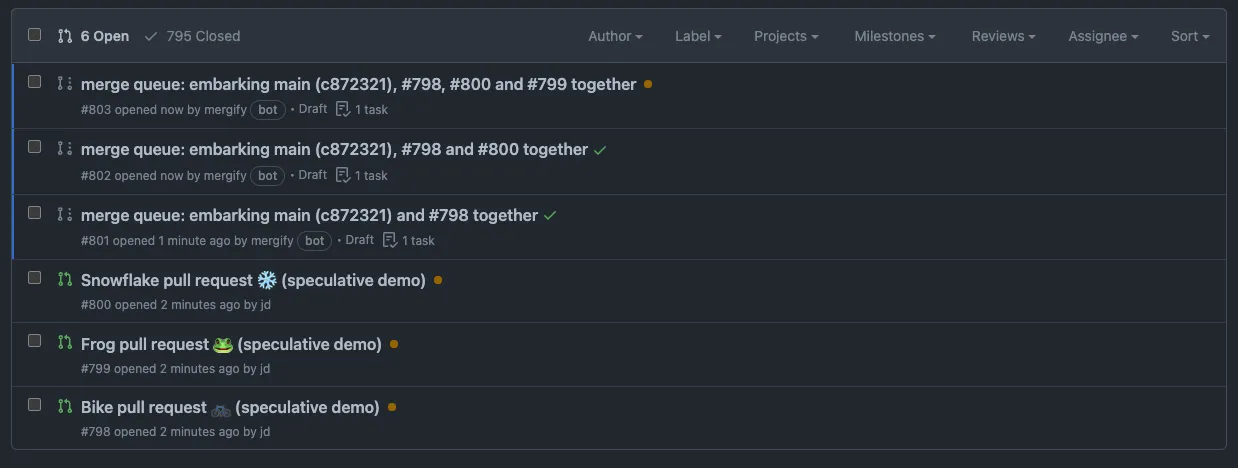Parallel Checks
Accelerates the merging process by testing the compatibility of multiple queued pull requests in parallel.
Parallel Checks let Mergify test multiple queued pull requests together so you ship faster. Mergify creates temporary draft PRs that represent cumulative merges (PR#1), (PR#1+PR#2), (PR#1+PR#2+PR#3), runs CI on them in parallel, then merges the original PRs once checks pass.
How Parallel Checks Work
Section titled How Parallel Checks WorkMergify groups PRs by their position in the queue and the max_parallel_checks
value. It creates draft PRs that speculatively combine changes and runs your CI
on each in parallel. For example, with PR #1–#5 and max_parallel_checks: 3,
Mergify creates:
- Draft #1: PR #1
- Draft #2: PR #1 + PR #2
- Draft #3: PR #1 + PR #2 + PR #3
This validates the combined outcome ahead of time against your queue_rules.
If a draft fails, Mergify removes the culprit PR from the queue and continues
with the rest.

The result: fewer head-of-line stalls, faster merges, and earlier detection of incompatibilities.
Configuring Parallel Checks
Section titled Configuring Parallel ChecksSet merge_queue.max_parallel_checks to control how many speculative checks run at once:
merge_queue:
max_parallel_checks: 3This example runs up to 3 speculative checks simultaneously. Tune this number to match your CI capacity and typical PR size/complexity.
When Things Change
Section titled When Things ChangeParallel Checks adapt automatically as your code and rules evolve:
-
Failed checks: Mergify removes the failing PR and continues with the rest.
-
PR or rule changes: affected PRs are re-evaluated and re-embarked in order.
-
Base branch updates: checks restart on the new base; configurable via
reset_on_external_merge— see Lifecycle: Base Branch Updates.
Skip Intermediate Results
Section titled Skip Intermediate ResultsBy default, each speculative draft that includes a pull request must pass
before that pull request can be merged. When
merge_queue.skip_intermediate_results is enabled, Mergify can merge a pull
request as soon as a later downstream draft that also includes that PR passes,
even if earlier intermediate drafts failed.
When to use it:
-
Your CI is stable (low flakiness) and long-running, and you want to reduce latency by trusting the first comprehensive passing draft.
-
You’re using parallel checks and/or batches and care more about the final combined outcome than each incremental step.
Enable it in your configuration:
merge_queue:
skip_intermediate_results: trueImportant Considerations
Section titled Important ConsiderationsIn‑place checks (no drafts)
Section titled In‑place checks (no drafts)Mergify runs checks directly on the original pull request (instead of using temporary draft PRs) only when of the following are true:
-
queue_rules[*].batch_size = 1 -
merge_queue.max_parallel_checks = 1 -
No two‑step CI is configured (i.e., no separate
merge_conditionsbeyondqueue_conditionsin your queue rules) -
Optionally, set
update_bot_accountto avoid in‑place updates blocked by GitHub for security reasons (e.g., PRs from forks that modify workflows, or PRs opened by other bots)
Example configuration enabling in‑place checks:
merge_queue:
max_parallel_checks: 1
queue_rules:
- name: default
batch_size: 1
# use a single set of checks (no two‑step split between queue vs merge)
queue_conditions:
- check-success = ci
update_bot_account: my-org-botBranch Protection Settings
Section titled Branch Protection SettingsParallel checks operate by creating temporary pull requests, which merge
multiple PRs with the base branch. This process requires the branch protection
setting Require branches to be up to date before merging to be disabled.
This does not mean that Mergify will test outdated PRs, but it will merge the original pull requests once its parallel checks is finished. The original PR won’t be up-to-date according to GitHub, which means using this setting would block the merge.
Tuning parallel checks
Section titled Tuning parallel checksAdjust max_parallel_checks to balance throughput and CI usage. Higher values
increase concurrency; choose a value your CI can handle reliably. For deeper
guidance and trade‑offs (including batching), see Merge queue
performance.